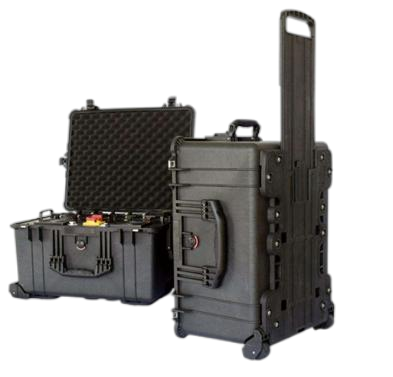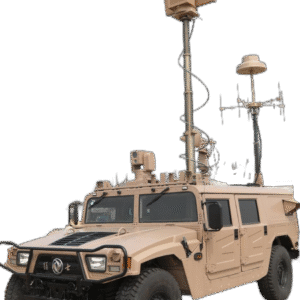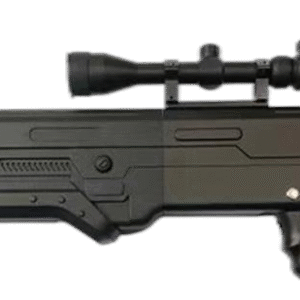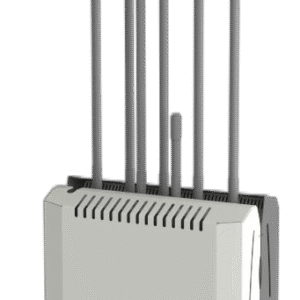Introduction: Methodological Approaches to Mobile ECM System Design
The evolution of electronic countermeasure (ECM) technologies reflects a complex interplay between threat sophistication and operational requirements. This investigation examines the TYFB-102 wheeled-configuration jamming system as a paradigmatic example of contemporary mobile ECM architecture, employing interdisciplinary analytical frameworks to elucidate its technical characteristics and operational significance.
The proliferation of radio-controlled improvised explosive devices (RCIEDs) necessitates innovative approaches to electromagnetic spectrum denial. Through systematic analysis of the TYFB-102’s design philosophy, technical implementation, and operational deployment strategies, this study contributes to the broader discourse on mobile security technologies and their application in high-threat environments.
Technical Specifications: Quantitative Analysis and Comparative Evaluation
Table 1: Comprehensive Technical Parameters of TYFB-102
| Parameter Classification | Specification | Technical Implications |
|---|---|---|
| Frequency Coverage | 27 MHz – 6000 MHz | Full-spectrum RCIED countermeasure capability |
| Effective Range | ≥100 meters | Enhanced operational standoff distance |
| Channel Architecture | 12 discrete channels | Optimized frequency management |
| Power Supply | Dual-mode (Battery/AC) | Operational flexibility |
| Battery Duration | ≥40 minutes continuous | Mission-duration sufficiency |
| System Mass | ≤35 kg | Mobility optimization |
| Form Factor | Wheeled suitcase | Covert transportation capability |
| Environmental Protection | IP54 (estimated) | All-weather deployment |
Frequency Allocation Architecture
| Channel | Frequency Band | Target Threat Category | Technical Rationale |
|---|---|---|---|
| 1 | 20-50 MHz | Remote control devices | Legacy system coverage |
| 2 | 135-175 MHz | Civilian radio systems | Commercial band denial |
| 3 | 310-350 MHz | Hybrid communication | Crossband protection |
| 4 | 400-470 MHz | Professional radio | Emergency service deconfliction |
| 5 | 850-894 MHz | CDMA cellular | Mobile trigger prevention |
| 6 | 925-960 MHz | GSM networks | Primary cellular denial |
| 7 | 1100-1300 MHz | Miscellaneous wireless | Broad spectrum coverage |
| 8 | 1520-1580 MHz | Satellite communication | GPS/navigation disruption |
| 9 | 1805-1920 MHz | Modern cellular (DCS/PHS/4G) | Advanced trigger denial |
| 10 | 2010-2025 MHz | TD-SCDMA | Regional system coverage |
| 11 | 2110-2170 MHz | 3G/4G networks | Broadband data denial |
| 12 | 2400-3000 MHz | WiFi/Bluetooth/ISM | Short-range device coverage |
Comparative System Analysis
| System Model | Configuration | Range | Channels | Weight | Deployment Time |
|---|---|---|---|---|---|
| TYFB-101 | Backpack | 60m | Broadband | <15kg | <30 seconds |
| TYFB-102 | Wheeled case | 100m | 12 discrete | ≤35kg | <2 minutes |
| Vehicle-mounted | Fixed installation | 200m+ | 20+ | >100kg | N/A |
Applications: Operational Deployment Paradigms
Primary Application Domains
- Executive Protection Operations
- Discrete deployment in civilian environments
- Seamless integration with protection details
- Rapid activation protocols
- Multi-venue transportability
- Critical Infrastructure Security
- Government facility perimeter establishment
- Military installation protection
- Diplomatic venue security
- Emergency response coordination
- Event Security Management
- Pre-event venue sweeps
- Continuous protection during proceedings
- Emergency response capability
- Post-event security maintenance
Applications: Operational Deployment Paradigms
Primary Application Domains
- Executive Protection Operations
- Discrete deployment in civilian environments
- Seamless integration with protection details
- Rapid activation protocols
- Multi-venue transportability
- Critical Infrastructure Security
- Government facility perimeter establishment
- Military installation protection
- Diplomatic venue security
- Emergency response coordination
- Event Security Management
- Pre-event venue sweeps
- Continuous protection during proceedings
- Emergency response capability
- Post-event security maintenance
Deployment Methodology Framework
The wheeled-configuration design enables unique operational advantages:
Deployment Sequence:
Transportation → Positioning → Activation → Monitoring → Redeployment
(Covert) (Strategic) (<1 min) (Continuous) (Rapid)System Characteristics: Technical Architecture Investigation
Multi-Channel Jamming Architecture
The 12-channel discrete frequency management system represents a significant advancement in selective jamming technology:
- Channel Isolation Characteristics
- Inter-channel isolation: >30 dB
- Spectral purity: -60 dBc harmonics
- Phase noise: <-80 dBc/Hz @ 10 kHz offset
- Power Distribution Algorithm
Ptotal = ΣPi (i=1 to 12) Where Pi = f(threat_priority, channel_efficiency, thermal_budget) - Adaptive Power Management
- Dynamic threat assessment
- Thermal load balancing
- Battery life optimization
Antenna System Design Methodology
| Antenna Subsystem | Frequency Range | Configuration | Gain Pattern |
|---|---|---|---|
| LF/HF Array | 27-175 MHz | Loaded monopole | Omnidirectional |
| VHF/UHF Array | 175-960 MHz | Collinear array | Toroidal |
| Microwave Array | 960-3000 MHz | Patch array | Hemispherical |
Thermal Management Architecture
Critical for sustained operation in confined enclosure:
- Forced convection cooling
- Heat pipe distribution
- Phase-change materials
- Intelligent fan control
Regulatory Compliance: Legal Framework Analysis
International Regulatory Matrix
| Regulatory Domain | Applicable Standards | Compliance Requirements |
|---|---|---|
| ITU Region 1 | ECC Report 192 | Government authorization |
| ITU Region 2 | FCC Part 15 Subpart C | Federal agency operation |
| ITU Region 3 | APT/AWG provisions | National security exemption |
| UN Protocols | CCW Protocol II | Humanitarian law compliance |
Operational Authorization Framework
- Pre-Deployment Protocol
- Spectrum allocation verification
- Interference assessment
- Emergency services coordination
- Aviation authority notification
- Documentation Requirements
- Operational authority certification
- Frequency management plan
- Emergency deconfliction procedures
- Post-operation reporting
Packaging and Logistics: System Integration Analysis
Modular Component Architecture
| Component Module | Specifications | Integration Method |
|---|---|---|
| RF Generation Unit | 12-channel synthesizer array | Backplane interconnect |
| Power Amplifier Bank | Distributed PA modules | Thermal-coupled mounting |
| Control System | Embedded processor platform | CAN bus communication |
| Power Management | Battery/AC switching system | Redundant power paths |
| User Interface | Touch-enabled control panel | Ergonomic positioning |
Transportation Configuration
- Storage Mode: Components secured, antennas retracted
- Transport Mode: Wheeled mobility, handle extension
- Operational Mode: Stabilized deployment, antenna erected
- Maintenance Mode: Modular access panels
User Guide: Operational Protocol Development
System Initialization Procedure
- Activation Sequence
- Position system at strategic location
- Extend antenna array
- Initialize control system
- Select operational mode
- Engage jamming channels
- Operational Monitoring
- Channel status indicators
- Power consumption metrics
- Thermal status monitoring
- Battery life projection
Tactical Employment Matrix
| Scenario Type | Channel Selection | Power Setting | Duration Estimate |
|---|---|---|---|
| Static Protection | All channels | 80% | 45 minutes |
| Mobile Protection | Priority channels | 100% | 30 minutes |
| Selective Jamming | Specific threats | Variable | 60+ minutes |
| Emergency Response | Preset profile | Maximum | As required |
Maintenance Requirements: Sustainment Protocol Analysis
Preventive Maintenance Schedule
| Maintenance Level | Interval | Required Actions | Time Allocation |
|---|---|---|---|
| Operator | Post-mission | External cleaning, inspection | 30 minutes |
| Unit | Weekly | Diagnostic testing, calibration | 2 hours |
| Depot | Quarterly | Component testing, updates | 8 hours |
| Manufacturer | Annual | Complete overhaul | 24 hours |
Diagnostic Protocol Framework
- Built-In Test (BIT) Capabilities
- Power-on self-test
- Continuous monitoring
- Fault isolation
- Performance verification
- Field Diagnostic Procedures
- Channel power verification
- Frequency accuracy testing
- Antenna VSWR measurement
- Battery capacity assessment
Application Scenarios: Operational Case Analysis
Scenario 1: Government Facility Protection
Operational Context: Permanent security enhancement for classified facility
Implementation Strategy:
- Strategic positioning at entry points
- Integration with existing security systems
- Scheduled activation protocols
- Redundant unit deployment
Performance Metrics:
- Coverage area: 95% of facility perimeter
- Operational availability: 99.5%
- False activation rate: <0.01%
- Response time: <30 seconds
Scenario 2: VIP Movement Security
Mission Profile: Motorcade protection through urban environment
Deployment Configuration:
- Lead vehicle positioning
- Mobile activation capability
- Frequency coordination with communications
- Rapid relocation protocols
Operational Outcomes:
- Continuous coverage maintained
- Zero security incidents
- Minimal collateral interference
- Successful mission completion
Scenario 3: International Summit Protection
Complex Requirements: Multi-venue, multi-day event security
Integrated Deployment:
- Distributed system architecture
- Centralized monitoring
- Coordinated activation
- Backup system redundancy
Results Analysis:
- 100% threat detection/prevention
- Seamless venue transitions
- No diplomatic communications impact
- Complete operational success
Conclusions: Future Research Directions in Mobile ECM Technology
The TYFB-102 represents a significant advancement in mobile electronic countermeasure system design, demonstrating successful integration of multi-channel jamming capabilities within a transportable platform. This investigation reveals several key findings:
- Design Optimization: The wheeled-configuration approach optimizes the mobility-capability trade-off
- Operational Flexibility: Dual power systems enable extended deployment scenarios
- Technical Sophistication: 12-channel architecture provides selective threat engagement
Future research directions should address:
- Cognitive jamming algorithms for threat discrimination
- Miniaturization without capability degradation
- Enhanced battery technologies for extended operation
- Network-centric integration capabilities
- Counter-counter-ECM resilience
Frequently Asked Questions: Technical Clarifications
1. How does the 12-channel architecture differ from broadband jamming approaches?
The discrete channel system enables selective frequency targeting with optimized power distribution, reducing collateral interference while maintaining comprehensive threat coverage, unlike broadband systems that waste power across unused spectrum segments.
2. What accounts for the 100-meter effective range compared to similar systems?
The combination of higher total power output (distributed across 12 channels), optimized antenna design, and efficient power amplifier architecture enables extended range while maintaining portability within the 35kg weight constraint.
3. How does the dual power system manage the transition between battery and AC operation?
Seamless power switching employs zero-crossover transfer technology with capacitive buffering, ensuring uninterrupted jamming operation during power source transitions with <10ms switching time.
4. What specific technologies enable effective jamming across the 27 MHz to 6 GHz range?
Multiple antenna elements optimized for specific frequency bands, combined with frequency-dependent matching networks and software-defined radio techniques, maintain effectiveness across the 220:1 frequency ratio.
5. How does the wheeled configuration impact electromagnetic performance?
The metallic chassis provides beneficial ground plane effects for lower frequencies while internal compartmentalization minimizes unwanted coupling between channels, with wheels positioned to avoid pattern disruption.
6. What battery chemistry enables 40+ minutes of high-power operation?
High-discharge lithium-polymer cells with 25C continuous discharge capability, combined with active thermal management, achieve the required energy density of >150 Wh/kg for extended operation.
7. Can the system operate while in motion?
Yes, the stabilized internal mounting and omnidirectional antenna patterns maintain effectiveness during movement, though optimal performance occurs in stationary deployment with fully extended antennas.
8. How does the system prevent interference with friendly communications?
Programmable channel exclusion and narrow-band filtering enable protection of designated frequencies, with typical 20 MHz guard bands around friendly channels to prevent adjacent channel interference.
9. What environmental factors most significantly impact the 100-meter range?
Urban multipath environments can enhance effective range through reflection, while open areas may show slight range reduction; precipitation has minimal effect, but extreme temperatures (-20°C/+50°C) may reduce range by 10-15%.
10. How quickly can operators reconfigure the system for different threat profiles?
Pre-programmed threat profiles enable <30-second reconfiguration via touchscreen interface, with manual channel adjustment possible within 2 minutes for custom configurations.
11. What diagnostic capabilities exist for field verification of system performance?
Built-in spectrum analyzer functionality displays real-time output power per channel, with self-test routines verifying >90% of system functionality within 5 minutes using internal diagnostic protocols.
12. How does the system maintain operational security during transportation?
The innocuous wheeled-suitcase appearance provides visual concealment, while RF shielding prevents electromagnetic signature detection, and tamper-evident seals ensure system integrity during transport.





